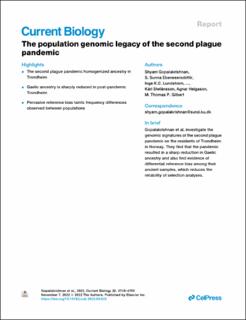| dc.contributor.author | Gopalakrishnan, Shyam | |
| dc.contributor.author | Ebenesersdottir, S. Sunna | |
| dc.contributor.author | Lundstrøm, Inge K. C. | |
| dc.contributor.author | Turner-Walker, Gordon | |
| dc.contributor.author | Moore, Kristjan H. S. | |
| dc.contributor.author | Luisi, Pierre | |
| dc.contributor.author | Magaryan, Ashot | |
| dc.contributor.author | Martin, Michael D. | |
| dc.contributor.author | Ellegaard, Martin Rene | |
| dc.contributor.author | Magnusson, Olafur T. | |
| dc.contributor.author | Sigurdsson, Asgeir | |
| dc.contributor.author | Snorradóttir, Steinunn | |
| dc.contributor.author | Magnúsdóttir, Droplaug N. | |
| dc.contributor.author | Laffoon, Jason E. | |
| dc.contributor.author | van Dorp, Lucy | |
| dc.contributor.author | Liu, Xiaodong | |
| dc.contributor.author | Moltke, Ida | |
| dc.contributor.author | Avila-Arcos, María C. | |
| dc.contributor.author | Schraiber, Joshua G. | |
| dc.contributor.author | Rasmussen, Simon | |
| dc.contributor.author | Juan, David | |
| dc.contributor.author | Galabert, Pere | |
| dc.contributor.author | De-Dios, Toni | |
| dc.contributor.author | Fotakis, Anna K. | |
| dc.contributor.author | Iraeta-Orbegozo, Miren | |
| dc.contributor.author | Vågene, Åshild J. | |
| dc.contributor.author | Denham, Sean Dexter | |
| dc.contributor.author | Christophersen, Axel | |
| dc.contributor.author | Stenøien, Hans K. | |
| dc.contributor.author | Vieira, Filipe G. | |
| dc.contributor.author | Liu, Shanlin | |
| dc.contributor.author | Günther, Torsten | |
| dc.contributor.author | Kivisild, Toomas | |
| dc.contributor.author | Moseng, Ole Georg | |
| dc.contributor.author | Skar, Birgitte | |
| dc.contributor.author | Cheung, Christina | |
| dc.contributor.author | Sandoval-Velasco, Marcela | |
| dc.contributor.author | Wales, Nathan | |
| dc.contributor.author | Schroeder, Hannes | |
| dc.contributor.author | Campos, Paula F. | |
| dc.contributor.author | Gudmundsdottir, Valdis B. | |
| dc.contributor.author | Sicheritz - Ponten, Thomas | |
| dc.contributor.author | Petersen, Bent | |
| dc.contributor.author | Halgunset, Jostein | |
| dc.contributor.author | Gilbert, Edmund | |
| dc.contributor.author | Cavalleri, Gianpiero L. | |
| dc.contributor.author | Hovig, Eivind | |
| dc.contributor.author | Kockum, Ingrid | |
| dc.contributor.author | Olsson, Tomas | |
| dc.contributor.author | Alfredsson, Lars | |
| dc.contributor.author | Hansen, Thomas F. | |
| dc.contributor.author | Werge, Thomas | |
| dc.contributor.author | Willerslev, Eske | |
| dc.contributor.author | Balloux, Francois | |
| dc.contributor.author | Marquès-Bonet, Tomás | |
| dc.contributor.author | Lalueza-Fox, Carles | |
| dc.contributor.author | Nielsen, Rasmus | |
| dc.contributor.author | Stefánsson, Kári | |
| dc.contributor.author | Helgason, Agnar | |
| dc.contributor.author | Gilbert, Thomas P. | |
| dc.date.accessioned | 2022-11-17T09:26:49Z | |
| dc.date.available | 2022-11-17T09:26:49Z | |
| dc.date.created | 2022-10-13T14:01:11Z | |
| dc.date.issued | 2022 | |
| dc.identifier.citation | Gopalakrishnan, S., Ebenesersdóttir, S. S., Lundstrøm, I. K. C., Turner-Walker, G., Moore, K. H. S., Luisi, P., Margaryan, A., Martin, M. D., Ellegaard, M. R., Magnússon, Ó. þ., Sigurðsson, Á., Snorradóttir, S., Magnúsdóttir, D. N., Laffoon, J. E., van Dorp, L., Liu, X., Moltke, I., Ávila-Arcos, M. C., Schraiber, J. G., . . . Gilbert, M. T. P. (2022). The population genomic legacy of the second plague pandemic. Current Biology, 32(21), 4743-4751. | en_US |
| dc.identifier.issn | 0960-9822 | |
| dc.identifier.uri | https://hdl.handle.net/11250/3032312 | |
| dc.description.abstract | Human populations have been shaped by catastrophes that may have left long-lasting signatures in their genomes. One notable example is the second plague pandemic that entered Europe in ca. 1,347 CE and repeatedly returned for over 300 years, with typical village and town mortality estimated at 10%–40%.1 It is assumed that this high mortality affected the gene pools of these populations. First, local population crashes reduced genetic diversity. Second, a change in frequency is expected for sequence variants that may have affected survival or susceptibility to the etiologic agent (Yersinia pestis).2 Third, mass mortality might alter the local gene pools through its impact on subsequent migration patterns. We explored these factors using the Norwegian city of Trondheim as a model, by sequencing 54 genomes spanning three time periods: (1) prior to the plague striking Trondheim in 1,349 CE, (2) the 17th–19th century, and (3) the present. We find that the pandemic period shaped the gene pool by reducing long distance immigration, in particular from the British Isles, and inducing a bottleneck that reduced genetic diversity. Although we also observe an excess of large FST values at multiple loci in the genome, these are shaped by reference biases introduced by mapping our relatively low genome coverage degraded DNA to the reference genome. This implies that attempts to detect selection using ancient DNA (aDNA) datasets that vary by read length and depth of sequencing coverage may be particularly challenging until methods have been developed to account for the impact of differential reference bias on test statistics. | en_US |
| dc.language.iso | eng | en_US |
| dc.rights | Navngivelse 4.0 Internasjonal | * |
| dc.rights.uri | http://creativecommons.org/licenses/by/4.0/deed.no | * |
| dc.title | The population genomic legacy of the second plague pandemic | en_US |
| dc.type | Peer reviewed | en_US |
| dc.type | Journal article | en_US |
| dc.description.version | publishedVersion | en_US |
| dc.rights.holder | © 2022 The Authors. Published by Elsevier Inc. | en_US |
| dc.source.pagenumber | 4743-4751 | en_US |
| dc.source.volume | 32 | en_US |
| dc.source.journal | Current Biology | en_US |
| dc.source.issue | 21 | en_US |
| dc.identifier.doi | https://doi.org/10.1016/j.cub.2022.09.023 | |
| dc.identifier.cristin | 2061205 | |
| dc.source.articlenumber | e6 | en_US |
| cristin.ispublished | true | |
| cristin.fulltext | original | |
| cristin.qualitycode | 2 | |

